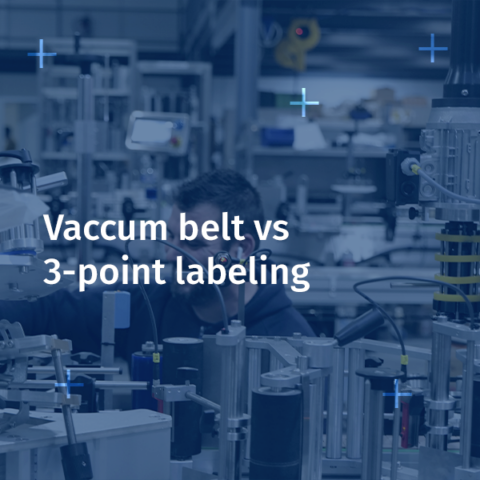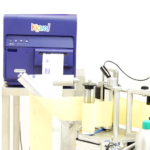Vaccum belt : an efficient solution for high speeds
Vaccum belt is a method commonly used for labeling cylindrical products such as bottles, vials, and jars. This technique involves feeding containers to the labeling station, where they are rotated using motorized bands that encircle the product. The label wraps around the container while smoothing out, without any stoppage.
Advantages of Vaccum belt:
- Full-wrap labeling: Ensures the label is applied all around the product, providing an aesthetically pleasing presentation.
- High speed: Ideal for large production runs due to its continuous, fast labeling process.
Disadvantages of Vaccum belt:
- Precision required: Incorrect label tension can lead to misalignment, affecting the quality of the label application.
- Less versatile: This method is only suitable for cylindrical containers with no significant reliefs or complex shapes.
The Ninon Wrap: our banding labeler
The Ninon Wrap is specifically designed for banding, offering continuous and uniform label application for cylindrical products.
Key features:
- Fast speed: Thanks to Vaccum belt technology, it ensures quick label application.
- Ease of use: Simple and intuitive control thanks to its user-friendly interface.
- Format memory: Capable of storing up to 50 formats, allowing for quick changes and time-saving in production.
Thanks to its Vaccum belt process, the Ninon Wrap is an ideal choice for industries looking to combine productivity and high-quality labeling without compromise.
3-Point labeling: a precise and adaptable solution
The 3-point labeling technique can be used for a wide variety of products and shapes, including cylindrical, rectangular, conical, oval, and more. In this system, the product is fed to the labeling station, where it is rotated using a smoothing roller and pressing cylinder. During rotation, one or more labels are applied to the product.
This method is especially appreciated for products requiring perfect label placement, such as in the cosmetics sector, where precision is critical for various shapes and formats.
Advantages of 3-point labeling:
- High precision: Ensures perfect alignment, even on textured surfaces, resulting in better visual quality.
- Versatility: Compatible with various container formats (oval, rectangular, or conical products).
Disadvantages of 3-point labeling:
- Limited speed: Slower than banding for large production runs, which may slow down production for high volumes.
- Less effective for very small or large products: Mechanical constraints of the three-point system may limit its use for certain container sizes.
Solo & Ninon Series: 3-Point labeling for your products
At CDA USA, both the Solo and Ninon range utilize 3-point labeling technology to offer a reliable and easily integrated solution for diverse productions.
- Solo range: Compact and efficient, it ensures clean and consistent label application, regardless of product format.
- Ninon range: Designed for higher speeds, it allows up to five labels per container, providing significant time savings for production lines with varied products.
With these two solutions, CDA offers precise, adaptable, and high-performance labeling, while remaining easy to use.
Which solution to choose?
The choice between Vaccum belt and 3-point labeling depends on your production needs and product characteristics:
- For large batches with standard formats? Choose banding for high speed and efficiency.
- For products requiring high precision and adaptability to different formats? Opt for 3-point labeling for perfect alignment.
- Need an adaptable machine? Some machines combine both methods for optimal flexibility.
Both Vaccum belt and 3-point labeling are effective solutions that meet different needs. The choice between these methods will primarily depend on your requirements for speed, precision, and the type of product being labeled.







